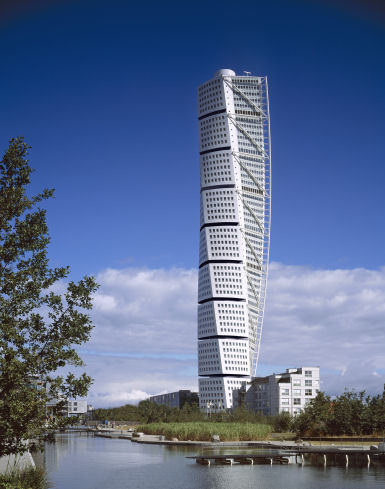Sustainability is the motto of the Western Harbour (Vaestra Hamnen) project in the southern city of Malmo. There are futuristic buildings sporting massive glass windows and glinting solar panels.But turn a corner and you find a green courtyard with a little pond and some modest timber structures that remind you of Swedish villages."I really like the diversity of houses - and they've made it easy here to live in a sustainable way," says Helena Parker, who was among the first to move into the area in 2001.A former shipyard and industrial site is being turned into a green residential area based on 100% use of renewable energy.
The planners devoted plenty of space to greenery and water features. And there are no high-density tower blocks, except for the Turning Torso - a graceful 190m (627ft) skyscraper designed by Santiago Calatrava.

Parking space is limited to 0.7 cars per apartment, compared with the usual 1.1 for Malmo, and garages are underground.
Architect and planner Hans Olsson says the project drew inspiration from the plan of medieval Lund, a nearby town. "We wanted a human scale, small streets."
Taller buildings are on the outside, facing the sea and sheltering the inner spaces. Passages to the sea are narrow to keep the wind out.
Bo01 has an open drainage system which traps rainwater on numerous living green roofs, in courtyard ponds and open channels. That allows the water to run off slowly into a saltwater canal or the sea.
The ponds and canal not only look attractive - they provide habitats for wildlife, creating biodiversity.
Jon Andersson, energy coordinator for the project, says there were initial fears in Malmo that "exclusive" flats would be built, just for the rich.
But student flats account for 34% of the homes in Bo01 and there is also a retirement complex, while the seaside walkway is enjoyed by residents and non-residents alike.
A nearby 2MW wind turbine provides much of the electricity for Bo01, the rest coming from solar panels. Solar collectors on 10 of the buildings provide 15% of the heating, but a more important source is a heat pump connected to aquifers 90m (297ft) underground.
Oil-free future
The sustainable measures were backed by 250m kronor (£18.5m; $34m) from the Swedish government and 1.9m euros (£1.3m; $2.4m) from the EU.
Most of Sweden's electricity comes from nuclear and hydropower - but green solutions are part of a plan to wean the nation off oil. Housing accounts for about 40% of Sweden's energy consumption.
The energy-saving star of Bo01 is probably the small, well-insulated LB house, no more expensive to build than a conventional home.
Its energy consumption is 87kWh per sq m annually - compared with about 200kWh per sq m for some other buildings in Bo01.
Fast forward to 2009... and the news out of Malmo, as reported by the enterprising Maria Colena, is encouraging:
Western Harbour, a former shipyard now densely urban, runs on 100-percent renewable energy from sun, wind and hydropower, as well as biofuels generated from organic waste. Its buildings are constructed with sustainable materials and designed to be energy efficient, and its streets are pedestrian and cycle friendly -- 40 percent of commuters and 30 percent of all travelers go by bike [source: PV Upscale - Full report on Malmo at this link/pdf] .
Additionally, the restoration of the area of Sege Park, another eco-friendly transformation, will power the neighborhood with green energy sources including photovoltaics (solar electricity), wind power and biofuels.
Augustenborg, a district that's been going green over the past decade, is known for its green roofing -- botanical roof gardens that reduce runoff and add insulation and vegetation to an urban neighborhood. Augustenborg is also home to the world's first emissions-free electric street trains, as well as more than a dozen recycling houses processing about 70 percent of collected waste [source: Ekostaden.com].


Like it.
ReplyDeleteThe Western Harbour is a great place. I wish more cities did what Malmo do.
ReplyDeleteThis is wonderful posting. Thank you.
ReplyDeleteBathmate
This is wonderful posting. Thank you.
ReplyDeleteBathmate
Right away I am going away to do my breakfast, once
ReplyDeletehaving my breakfast coming yet again to read additional news.
Feel free to visit my web page: diet plan to lose weight
golden goose
ReplyDeletegolden goose
supreme clothing
cheap jordans
yeezy
supreme new york
kyrie irving shoes
kyrie 7
a bathing ape
yeezy shoes